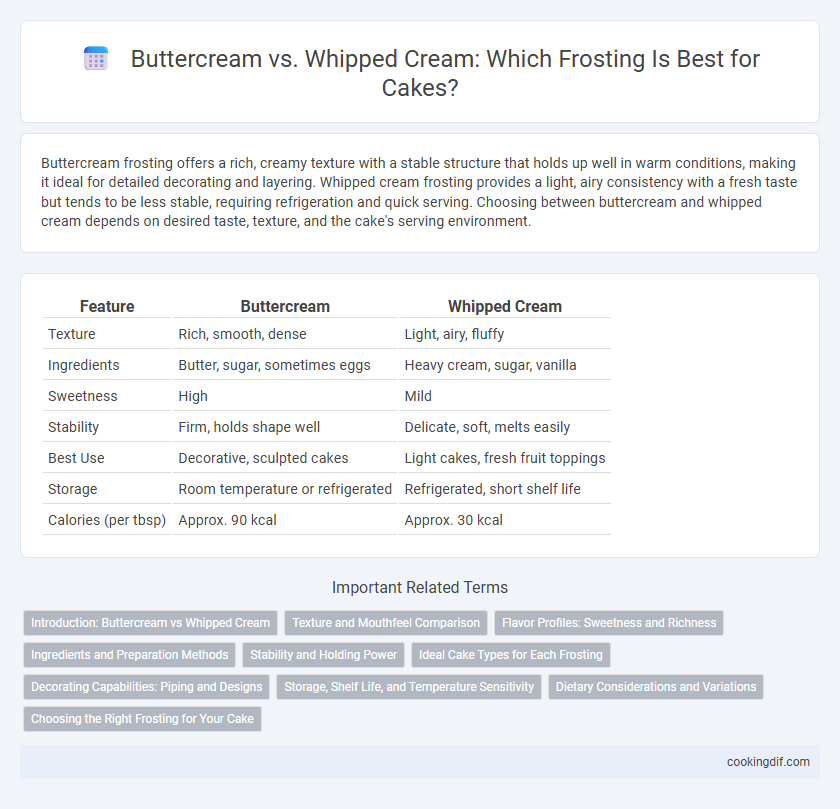Buttercream frosting offers a rich, creamy texture with a stable structure that holds up well in warm conditions, making it ideal for detailed decorating and layering. Whipped cream frosting provides a light, airy consistency with a fresh taste but tends to be less stable, requiring refrigeration and quick serving. Choosing between buttercream and whipped cream depends on desired taste, texture, and the cake's serving environment.
Table of Comparison
| Feature | Buttercream | Whipped Cream |
|---|---|---|
| Texture | Rich, smooth, dense | Light, airy, fluffy |
| Ingredients | Butter, sugar, sometimes eggs | Heavy cream, sugar, vanilla |
| Sweetness | High | Mild |
| Stability | Firm, holds shape well | Delicate, soft, melts easily |
| Best Use | Decorative, sculpted cakes | Light cakes, fresh fruit toppings |
| Storage | Room temperature or refrigerated | Refrigerated, short shelf life |
| Calories (per tbsp) | Approx. 90 kcal | Approx. 30 kcal |
Introduction: Buttercream vs Whipped Cream
Buttercream and whipped cream are two popular frosting options for cakes, each offering distinct textures and flavors. Buttercream provides a rich, creamy consistency with a sweet, buttery taste that holds shape well for detailed decorating. Whipped cream offers a lighter, airy texture with a subtle sweetness, ideal for a delicate finish but less stable in warm conditions.
Texture and Mouthfeel Comparison
Buttercream frosting offers a dense, creamy texture that provides a rich and indulgent mouthfeel, ideal for creating stable, sculpted cake designs. Whipped cream frosting is light and airy, delivering a soft, melt-in-the-mouth sensation that enhances delicate cakes but lacks the firmness for intricate decoration. The choice depends on whether a smooth, substantial bite or a fluffy, delicate finish is preferred for the cake.
Flavor Profiles: Sweetness and Richness
Buttercream frosting offers a rich, buttery flavor with pronounced sweetness due to its high sugar and butter content, creating a dense, creamy texture that complements dense cakes. Whipped cream frosting provides a lighter, less sweet taste with a subtle creaminess, balancing richness with a fluffy texture that pairs well with airy or fruit-based cakes. The choice between buttercream and whipped cream frosting depends on desired sweetness intensity and overall richness to match the cake's flavor profile.
Ingredients and Preparation Methods
Buttercream frosting combines butter and powdered sugar, often supplemented with milk or cream and flavorings, resulting in a rich, dense texture ideal for detailed cake decorations. Whipped cream frosting uses heavy cream whipped with sugar and sometimes stabilizers, creating a lighter, fluffier consistency best suited for soft, airy cakes. Preparation of buttercream involves creaming butter and sugar together until smooth, while whipped cream requires cold ingredients and careful whipping to achieve stiff peaks without overbeating.
Stability and Holding Power
Buttercream frosting offers superior stability and holding power compared to whipped cream, making it ideal for intricate cake designs and long-lasting decorations. Its higher fat content allows it to maintain shape and texture even at room temperature, while whipped cream is more prone to melting and deflating. Cakes frosted with buttercream are better suited for events requiring extended display times and transportation.
Ideal Cake Types for Each Frosting
Buttercream frosting, rich and dense with a buttery texture, is ideal for layered cakes like red velvet, carrot, and classic vanilla, providing stability and a smooth finish that holds intricate decorations. Whipped cream frosting, lighter and airier with a delicate sweetness, pairs perfectly with sponge cakes, angel food cakes, and fresh fruit cakes, enhancing their moisture without overwhelming the flavor. Choosing between buttercream and whipped cream depends on the cake's texture and desired presentation, ensuring the frosting complements rather than overshadows the cake.
Decorating Capabilities: Piping and Designs
Buttercream frosting excels in decorating capabilities due to its thick, stable texture, allowing for intricate piping and detailed designs that hold their shape well. Whipped cream, while light and airy, tends to be less stable and can lose definition in complex decorations, making it better suited for simpler, more rustic designs. For precise and elaborate cake artistry, buttercream remains the preferred choice among professional decorators.
Storage, Shelf Life, and Temperature Sensitivity
Buttercream frosting offers a longer shelf life and greater temperature stability, making it ideal for extended storage at room temperature or refrigeration without losing texture. Whipped cream frosting requires strict refrigeration and has a shorter shelf life, typically lasting only 1-2 days before it starts to weep or lose volume. Temperature sensitivity in whipped cream demands consistent cold conditions to maintain its structure, unlike buttercream which remains stable across a wider range of temperatures.
Dietary Considerations and Variations
Buttercream frosting, made primarily from butter and sugar, is rich in calories and saturated fats, making it less suitable for low-fat or dairy-free diets, while whipped cream frosting offers a lighter, lower-calorie alternative but contains dairy and may lack stability in warm conditions. Vegan and lactose-intolerant options for buttercream include using plant-based margarine or shortening, whereas whipped cream can be substituted with coconut cream or aquafaba for similar texture and taste. Both frostings can be flavored with natural extracts or fruit purees to enhance flavor profiles without compromising dietary restrictions.
Choosing the Right Frosting for Your Cake
Buttercream offers a rich, dense texture ideal for intricate piping and long-lasting decorations, making it perfect for layered cakes that need stability and flavor depth. Whipped cream provides a light, airy finish with a subtle sweetness, best suited for delicate sponge cakes or fresh fruit toppings where a less sweet, softer frosting is preferred. Selecting the right frosting depends on the cake's structure, flavor profile, and the desired aesthetic, balancing stability with taste and texture preferences.
Buttercream vs Whipped cream for cake frosting Infographic

 cookingdif.com
cookingdif.com